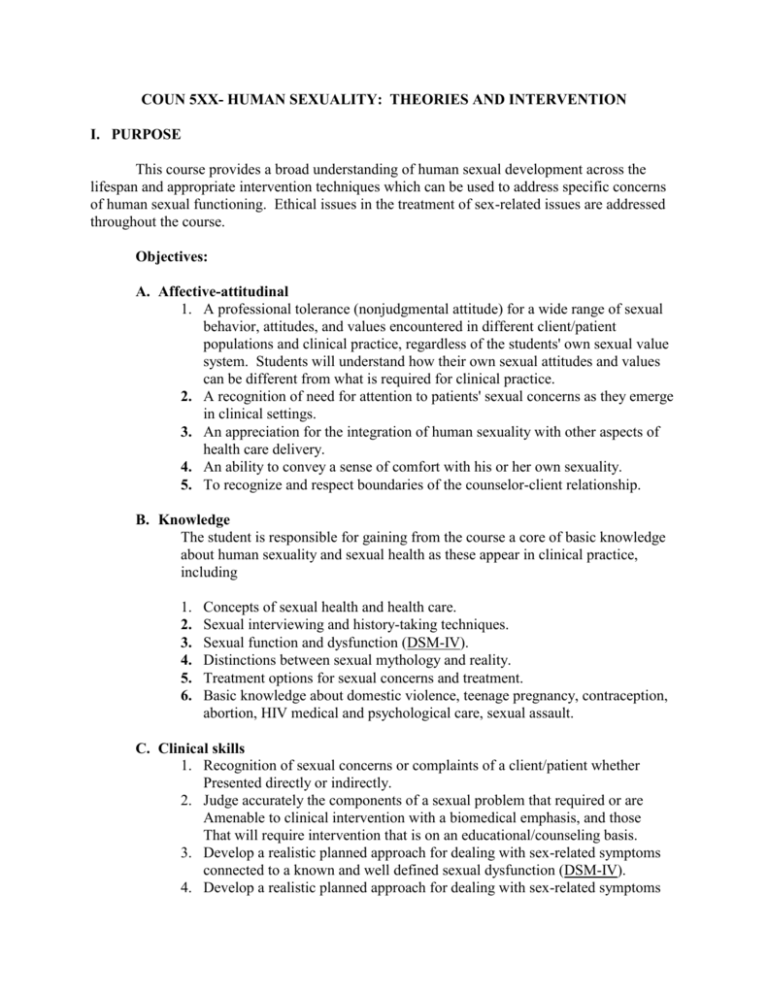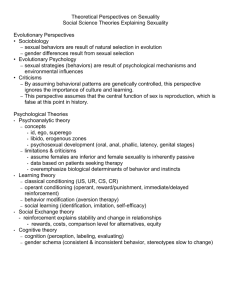
COUN 5XX- HUMAN SEXUALITY: THEORIES AND INTERVENTION
I. PURPOSE
This course provides a broad understanding of human sexual development across the
lifespan and appropriate intervention techniques which can be used to address specific concerns
of human sexual functioning. Ethical issues in the treatment of sex-related issues are addressed
throughout the course.
Objectives:
A. Affective-attitudinal
1. A professional tolerance (nonjudgmental attitude) for a wide range of sexual
behavior, attitudes, and values encountered in different client/patient
populations and clinical practice, regardless of the students' own sexual value
system. Students will understand how their own sexual attitudes and values
can be different from what is required for clinical practice.
2. A recognition of need for attention to patients' sexual concerns as they emerge
in clinical settings.
3. An appreciation for the integration of human sexuality with other aspects of
health care delivery.
4. An ability to convey a sense of comfort with his or her own sexuality.
5. To recognize and respect boundaries of the counselor-client relationship.
B. Knowledge
The student is responsible for gaining from the course a core of basic knowledge
about human sexuality and sexual health as these appear in clinical practice,
including
1.
2.
3.
4.
5.
6.
Concepts of sexual health and health care.
Sexual interviewing and history-taking techniques.
Sexual function and dysfunction (DSM-IV).
Distinctions between sexual mythology and reality.
Treatment options for sexual concerns and treatment.
Basic knowledge about domestic violence, teenage pregnancy, contraception,
abortion, HIV medical and psychological care, sexual assault.
C. Clinical skills
1. Recognition of sexual concerns or complaints of a client/patient whether
Presented directly or indirectly.
2. Judge accurately the components of a sexual problem that required or are
Amenable to clinical intervention with a biomedical emphasis, and those
That will require intervention that is on an educational/counseling basis.
3. Develop a realistic planned approach for dealing with sex-related symptoms
connected to a known and well defined sexual dysfunction (DSM-IV).
4. Develop a realistic planned approach for dealing with sex-related symptoms
Not immediately recognizable as connected to an organic disease state or to a
known and well defined sexual dysfunction.
5. Give accurate and relevant information to clients/patients regarding their
Sexual concerns or problems.
6. Make effective referrals when appropriate to specialized resources for the
Treatment of sexual dysfunctions or sex-related problems.
(Model based on the program in Human Sexuality at the University of Minnesota).
II.
TEXT (REQUIRED):
Westheimer, R. K., & Lopater, S. (2002). Hman sexuality: A psychosocial perspective.
Philadelphia: Lippincott, Williams, and Williams.
III.
TEXTS (RECOMMENDED):
Barbach, L G. (1976). For yourself: The fulfillment of female sexuality. New York:
Signet.
Hyde, J. S. (1999). Understanding human sexuality (7th ed.). New York: McGraw-Hill.
Kessler, S. J. (1998). Lessons from the intersexed. New Brunswick, NJ: Rutgers
University Press.
Laird, J., & Green, R. J. (1998). Lesbians and gays in couples and families: A handbook
for therapists. San Francisco: Jossey-Bass.
Maines, R. P. (1999). The technology of orgasm: "Hysteria," the vibrator, and women's
sexual satisfaction. Baltimore: The Johns Hopkins University Press.
IV.
PROCEDURES
The instructional methods to be employed in this course will be lecture, discussion, small
group work, guest speakers, community visits, and liberal use of print and audiovisual media.
These methods are supplementary to attendance and careful reading of required texts.
V.
ASSIGNMENTS/EVALUATION
The design of this course allows for several methods of evaluation regarding each
student's performance.
A.
A final research paper (APA style) of approximately 20 pages (including title
2
page, abstract page, and references) will be submitted by each student at the next
to the last class of the semester. Each topic is to be approved by the professor.
This research paper is a major part of the work for this course, and is heavily
weighted in the final grading. As part of the development of the research paper,
the student will construct an annotated, working bibliography (10% of grade)
using CD-rom search techniques which will be submitted one month prior to the
completion of the research paper and as part of the final product. After surveying
appropriate titles, abstracts, and the original source material (when available), the
student will construct an annotated bibliography (APA format) of at least fifteen
(15) citations with abstracts, as well as his/her personal summary of this
information integrated with text and lecture information. A maximum of three
WWW sites may be used for this project. During the semester the professor will
evaluate and assist each student in the progress of his/her research on a voluntary
basis. (10%+30%=40%)
B.
Preparation of a sexual history which will focus on sexual development of an
adult modeled on the handout provided in class. (20%)
C.
Weekly preparation of a journal which focuses on reactions to course material,
guest speakers, and community instructional trips (30%).
D.
In-class participation in discussion which evidences preparation, reading of
assigned materials, and understanding of the issues involved. (10%)
3








